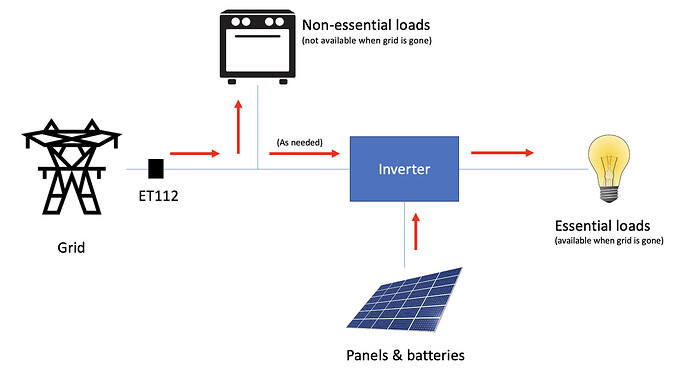OK, the first thing to understand is that the Multi has the ability to install assistants, which is a bit like apps on your cell phone: They allow the inverter to do more things than in its default configuration. One such assistant is the ESS assistant. That is critical to this explanation.
Normally the Multi’s inverter component is switched off when the grid is on. Only the charging part is active. When there is a grid outage, the Multi opens the relay to the grid (called the transfer switch, internally we also call it the backfeed relay for reasons I’m not perfectly clear about), and then it turns on the inverter. In other words, the default setup of the Multi is to work like a UPS.
When you install the ESS assistant, the Multi becomes an AC-coupled inverter. It can close the backfeed relay AND switch the inverter on at the same time, allowing it to feed energy into the grid.
Now if you look at the many pictures of the Multi online, you will see it is always drawn in the shape of a T. The grid is on the left, the backup loads are on the right, and the inverter/battery is at the bottom. There is a switch drawn in the left hand branch of the T (that is the backfeed relay, aka transfer switch). When running ESS, that switch is always closed, so you can think of it not being there.
If you now think of that inverter pushing energy into the top of the T, if it pushes in MORE than is on the right-hand side of that T, the rest is going to flow out into the left branch (towards the grid).
Alright, if you are still with me, now we introduce an energy meter. On that incoming branch of the Multi, there is an energy meter. So the Multi can balance the amount that it feeds in so that nothing flows into the left-hand branch, and only the loads on the output are compensated for. In other words, the “zero point”, the point in the system that the Multi keeps at zero (or rather, at whatever you set ESS setpoint to), is at the input of the Multi.
But… and this is the beauty, if you connect an external energy meter, then you can move the zero-point. Typically you will move the zero-point to the point where the utility connects to your installation, so that the Multi feeds all available power to loads within your installation. And that is where the ET112 comes in. It measures the energy use at a different spot in the installation, and the Multi then zeroes THAT point rather than it’s own input.
The reason why you do this, is twofold. The one is that it allows feeding excess energy to loads that are not on the output, which you don’t WANT on the output because they are too large (swimming pool pumps, geysers, stoves, etc). But it also saves a heap of rewiring.
What I mean by saving rewiring: You could get the same effect without the ET112, by placing your heavy loads on AC-Out-2. The Multi automatically drops AC-Out-2 when the grid fails. But that requires rewiring all those circuits, which may be more expensive than you think when considering things like outside buildings, garages, and the mentioned pool pumps, splitting the DB in some cases, etc etc. At the cost of an ET112, it’s often cheaper to do it that way.
